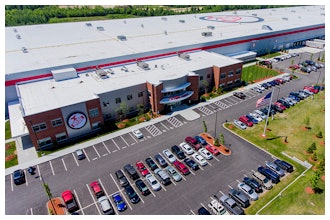Page 1 of 4
In this Q&A, experts from The CapStreet Group and KeyBanc Capital Markets® share their observations on
what an industrial distribution company owner can expect when preparing to sell a stake in the company.
As you consider the big decision to sell your business,
you would be well served to prepare the business to
attract potential buyers’ attention and maximize the
price it can command. Paul De Lisi, a partner with
The CapStreet Group, a private equity firm active in the
industrial distribution sector, and T.J. Monico and John
Newman, investment bankers and co-heads of the
Industrial Distribution & Logistics practice at KeyBanc
Capital Markets, provide an insider’s view of how to
prepare and what to expect.
What are some of the key
considerations for preparing
to sell one’s business?
De Lisi (CapStreet): The most attractive industrial
distribution business has a leadership team with
operational strength. They offer a big-picture view
of where the industry is headed and how their
company can succeed in that future. So, a team that
is considering selling its business should develop a
strategic plan (projections and vision) that articulates
a compelling story of how the company is going to
grow over the next three to five years.
Monico (KBCM): A vision for the future is vital—but
so is being able to explain the past. Owners who are
deciding whether or not to sell their business should
review their historical financial results and be able
to explain the changes in top-line results, margins,
working capital, and other similar metrics.
So You’re Considering a
Sale of Your Business –
Now What?
Essential Data to Gather Before a Sale
Sales and margin by customer, supplier,
salesperson
Branch-level results
Explanation of volume, pricing, working
capital trends, etc.
End markets served and associated trends
Monthly financials
Near-term (1 year) and long-term (2-3+ year)
projections
Strategic plan
Also, the owner should be clear about his or her
personal goals. If he or she wants to retire in the near
future, that plan should be stated upfront. The role of
the owner has a big impact on post-sale planning, and
the acquirer will want to factor succession planning
into the investment decision.
What specific kinds of information
does a seller need to gather for
potential buyers?
De Lisi (CapStreet): T.J. (Monico) is right—we want
to know what drove performance in the past and how
that performance “bridges” to projected results. If the
company does not have audited financials, having an
Page 2 of 4
audit performed can help prepare the team
for a sale process. That being said, having
an audit is by no means a “must have” for
us—we have acquired numerous companies
that have not had audits previously. With or
without an audit, buyers almost always ask
to perform a quality-of-earnings analysis.
It may behoove the seller to perform his/her own QoE
analysis to understand all the potential issues in advance
of entering into discussions with potential buyers.
Newman (KBCM): One of the primary valuation metrics
buyers utilize is a multiple of earnings (typically EBITDA).
As a result, sellers should make sure that their earnings
accurately reflect the business as it will look under new
ownership. For example, expenditures that will go away
under new ownership (e.g., charitable contributions,
excessive salaries or T&E, salaries to non-employees,
one-time IT or legal costs), should be identified and
“added back” to the historical financial results.
What kinds of critical data do
owners typically find most
challenging to provide?
De Lisi (CapStreet): Many companies that we look
at are unable to provide detail behind their historical
results. For example, we like to look at sales and
margins broken down over time by numerous metrics,
including by customer, salesperson, supplier/product
line, branch, end markets, etc. This level of detail helps
us understand the business more completely—both
where it has been, and where we think it could go if
we were to make an investment. As with audits, this
type of information is a “nice to have,” but we have
made numerous acquisitions without having access
to this level of detail at the time of our investment.
Monico (KBCM): On occasion, we have found
that management teams have a hard time providing
sufficient backup for their projections,
particularly if those projections extend
beyond the standard one-year budget. As
previously discussed, buyers want to know
that the business has a long-term strategic
vision, and this vision is judged in part by the
rigor of the process by which the projections
are developed. Buyers like to see a rationale for the
vision, and “math” on how that rationale translates to
the projections—for example, substantiating growth to
a specific customer or customers by utilizing third-party
data on projected growth in the end markets that those
customers serve. Also, if adding sales personnel or new
branches is part of the story, then be prepared to back
up the projected new sales by highlighting historical
performance when new sales personnel or locations
were added in years past.
Other requests are bound to come up that are specific to
a business or a set of prospective buyers. To anticipate
those, it’s best to have an advisor “in the trenches” with
experience selling distribution companies specifically,
to help the owner anticipate diligence requests and
prepare the necessary information to accurately and
advantageously present the value proposition.
What are common mistakes that
owners make when preparing for
the sale of a company?
Newman (KBCM): Owners are often surprised by
the time and effort required to provide the data and
documentation necessary to satisfy the diligence
needs of prospective buyers. A common mistake is
to understaff the preparation and ongoing effort—
often in the name of keeping the process confidential.
However, this under-resourcing can be extremely
counterproductive. Often, not having the correct or
enough personnel involved in the process results in
“The more completely an owner can document past performance, projected results, and underlying
assumptions, the easier it will be for potential buyers to not only see, but also believe in, the full
potential of the business.” T.J. Monico, KeyBanc Capital Markets
Page 3 of 4
incorrect data or delayed response times, which can in
turn lead to a delayed timetable or a lack of confidence
in the business team. It’s no surprise that these issues
will likely negatively impact valuation, turn off a desired
buyer or even scuttle the deal entirely.
De Lisi (CapStreet): Owners sometimes try to sell the
company when results are nearing a peak. Realistically,
it is hard to time a sale perfectly. An owner is more
likely to get a better valuation when the outlook for the
business is positive and the business has a runway for
future growth. Room for growth is particularly important
if the owner is going to either remain in an operational
role or participate in future upside by owning a portion
of the equity going forward, as is often the case when
selling to private equity.
What is a common misconception
about private equity?
De Lisi (CapStreet): Two common
misconceptions come to mind. First,
that all private equity firms are the
same. In fact, the numerous “styles”
of private equity substantially affect
how a management team works with
the new owners. For example, some
firms are actively involved with their
portfolio companies and engage in weekly discussions
with their management teams, whereas others are
more comfortable with quarterly strategic discussions.
In addition, many firms like to place former industry
executives on the boards of their portfolio companies,
whereas others maintain more informal board
structures. Understanding the differences between
various potential investors should inform a seller’s
decision on which partner to select. Valuation is clearly
important, but the selection of buyer should not be
based solely on price.
The second common misconception is that private
equity is short-term focused, aiming to cut costs to
grow the bottom line. In fact, most firms are more
focused on investing for growth to increase the
value of the company—whether by expanding the
management team or sales force, implementing a
more robust IT platform, investing more significantly in
working capital or making strategic acquisitions. We
look to add value by investing in infrastructure (e.g.,
IT, new locations, personnel) upfront, and then grow
the business organically and through acquisitions over
the life of our involvement.
Monico (KBCM): Some sellers believe that private
equity investors will maximize leverage to minimize
the equity that they have to invest—and that this will
prevent additional investment in the business going
forward. Frankly, we disagree with this outlook. While
debt is certainly utilized to finance the transaction,
often to a greater degree than a private owner is used
to, the leverage is not at a level that prevents investing
for growth. As Paul said previously, private equity firms
are focused on growth, and the last thing they want
to do is implement a capital structure that prevents
them from achieving the goals of the business.
How important is the management
team when you are evaluating an
investment opportunity?
De Lisi (CapStreet): Having a strong management
team in place that will remain with the company
long term is clearly a positive for us, but it is not a
requirement. We have invested in numerous situations
in which the owner intended to retire within the next
one to three years. We work very closely with our
companies on succession planning, and we are
comfortable transitioning an owner out of the business
if that is his or her goal. The key for
us is that the transition plan with
the CEO is clearly discussed before
closing the transaction. Our ultimate
goal is to have a management team
in place that will continue to drive the
business long after we have exited
the investment.
“We want to see a concise, decisive
strategic vision for the company.”
Paul De Lisi, CapStreet
Page 4 of 4
This article is for general information purposes only and does not consider the specific investment objectives, financial situation, and particular needs of any individual
person or entity.
KeyBanc Capital Markets is a trade name under which corporate and investment banking products and services of KeyCorp and its subsidiaries, KeyBanc Capital Markets
Inc., Member NYSE/FINRA/SIPC, and KeyBank National Association (“KeyBank N.A.”), are marketed. Securities products and services are offered by KeyBanc Capital
Markets Inc. and its licensed securities representatives, who may also be employees of KeyBank N.A. Banking products and services are offered by KeyBank N.A.
©2015 KeyCorp. ADL8245
Newman (KBCM): Whether the buyer is a private equity
investor or a large strategic buyer, the management team
is usually a very important ingredient in the investment
decision. Not to repeat an overused adage, but distribution
is a people business, so management continuity is
extremely important. And the quality of that next layer of
leadership—regional/branch managers, sales directors,
etc.—can also be important in driving buyer interest.
Are we in a good market
cycle for selling an industrial
distribution business?
Monico (KBCM): Today’s market remains extremely “seller
friendly.” With today’s oversupply of capital and robust
valuation multiples (particularly for distributors), there has
never been a better time than now to explore options. And
that is really all it is—exploring options. I agree with Paul that
many owners become too fixated on timing the market while
maximizing company performance. Today’s market affords
business owners the opportunity to monetize a portion or all
of the value they have created by making a strong argument
about the future potential of the company. Time and time
again, we have seen both private equity firms and corporate
acquirers pay big prices for companies that have strong
future potential.
De Lisi (CapStreet): It is clearly a good market for selling
a business, but another key consideration is to understand
how value will be created for the owner if he or she retains a
portion of the equity. Owners who partner with us typically
hang on to a portion of the equity to retain some of the
upside. Often, our owners have made more money on
rollover equity when we exited the business than when they
originally sold the business. So, as I mentioned earlier, it is
much more important to put your company in a position to
succeed with the right partner than to be concerned about
whether or not it is a good market for selling.
To learn more, contact:
Paul DeLisi
The CapStreet Group
713-332-2722
[email protected]
Visit capstreet.com
T.J. Monico
Industrial Distribution Investment Banking
KeyBanc Capital Markets
216-689-3079
[email protected]
John Newman
Industrial Distribution Investment Banking
KeyBanc Capital Markets
216-689-5496
[email protected]
Visit key.com/industrial
So You're Considering a Sale of Your Business - Now What?
In this white paper, private equity and investment banking experts share observations on what an industrial distribution company owner can expect when preparing to sell a stake in the company, and how to prepare the business to attract potential buyers' attention and maximize the price it can command.
Latest in Home






















